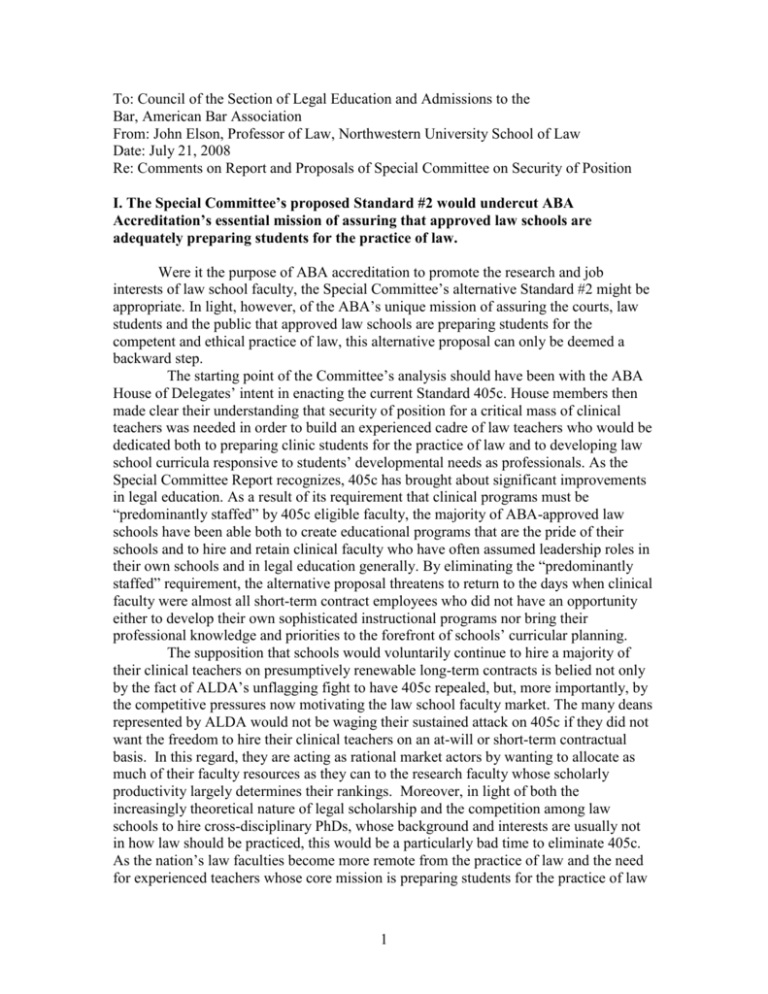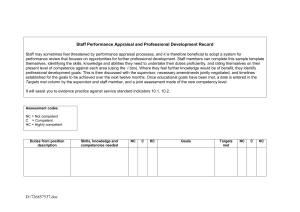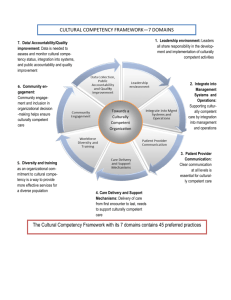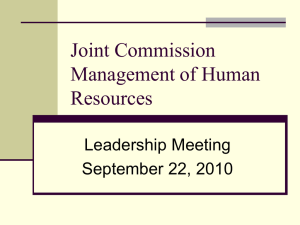John Elson, Professor of
advertisement

To: Council of the Section of Legal Education and Admissions to the Bar, American Bar Association From: John Elson, Professor of Law, Northwestern University School of Law Date: July 21, 2008 Re: Comments on Report and Proposals of Special Committee on Security of Position I. The Special Committee’s proposed Standard #2 would undercut ABA Accreditation’s essential mission of assuring that approved law schools are adequately preparing students for the practice of law. Were it the purpose of ABA accreditation to promote the research and job interests of law school faculty, the Special Committee’s alternative Standard #2 might be appropriate. In light, however, of the ABA’s unique mission of assuring the courts, law students and the public that approved law schools are preparing students for the competent and ethical practice of law, this alternative proposal can only be deemed a backward step. The starting point of the Committee’s analysis should have been with the ABA House of Delegates’ intent in enacting the current Standard 405c. House members then made clear their understanding that security of position for a critical mass of clinical teachers was needed in order to build an experienced cadre of law teachers who would be dedicated both to preparing clinic students for the practice of law and to developing law school curricula responsive to students’ developmental needs as professionals. As the Special Committee Report recognizes, 405c has brought about significant improvements in legal education. As a result of its requirement that clinical programs must be “predominantly staffed” by 405c eligible faculty, the majority of ABA-approved law schools have been able both to create educational programs that are the pride of their schools and to hire and retain clinical faculty who have often assumed leadership roles in their own schools and in legal education generally. By eliminating the “predominantly staffed” requirement, the alternative proposal threatens to return to the days when clinical faculty were almost all short-term contract employees who did not have an opportunity either to develop their own sophisticated instructional programs nor bring their professional knowledge and priorities to the forefront of schools’ curricular planning. The supposition that schools would voluntarily continue to hire a majority of their clinical teachers on presumptively renewable long-term contracts is belied not only by the fact of ALDA’s unflagging fight to have 405c repealed, but, more importantly, by the competitive pressures now motivating the law school faculty market. The many deans represented by ALDA would not be waging their sustained attack on 405c if they did not want the freedom to hire their clinical teachers on an at-will or short-term contractual basis. In this regard, they are acting as rational market actors by wanting to allocate as much of their faculty resources as they can to the research faculty whose scholarly productivity largely determines their rankings. Moreover, in light of both the increasingly theoretical nature of legal scholarship and the competition among law schools to hire cross-disciplinary PhDs, whose background and interests are usually not in how law should be practiced, this would be a particularly bad time to eliminate 405c. As the nation’s law faculties become more remote from the practice of law and the need for experienced teachers whose core mission is preparing students for the practice of law 1 becomes correspondingly greater, the repeal of 405c threatens the existence of exactly the type of law teachers who are now most needed to fulfill the ABA’s mission of assuring that approved law schools are adequately preparing students for the practice of law. The Special Committee’s rationale for its proposed Standard #2 is that existing 405c is unnecessary in light of the proposed standard’s reiteration of current Standard 405a’s requirement that schools must “maintain conditions adequate to attract and retain a competent faculty.” Reliance on a requirement of a competent faculty to assure the effectiveness of clinical programs, however, is misplaced for two reasons. First, the fact that a law school’s clinical teachers must be competent does not fulfill 405c’s original goal of assuring that law schools develop a cadre of experienced clinical teachers. Second, as discussed below, without fundamentally restructuring how competency is to be determined, this proposed Standard will be as ineffective as the current two faculty competency standards are in subjecting law faculty to meaningful assessment of their competency. II. Proposed Standard #2’s requirement that schools maintain conditions to attract and retain a competent faculty would be ineffectual as written. I am not aware of any publicly available statistics revealing how often law schools have been deemed in jeopardy of violating either Standard 401’s or 405a’s provisions requiring a competent faculty. However, on the basis of my own experience as a member of the Section’s Accreditation Committee and from conversations with two former members from different terms on that Committee, it seems clear that findings that law school faculties are not sufficiently competent are exceedingly rare, if not entirely nonexistent. This is not serendipitous. The accreditation process is simply not designed to make judgments as to the general competence of a law faculty, much less the more refined judgments needed to determine whether clinical teachers are adequate to nurture the development of students’ lawyering competencies. Denial of accreditation because too many of a school’s faculty are insufficiently incompetent would be a difficult judgment for anyone, but especially so for law faculty in regard to colleagues at other law schools. Such a professional condemnation is so damning that both Committee and site team members could not be expected to make an incompetency finding without both substantive criteria that are objective, specific and transparent and assessment methods that are valid, accurate and reliable. Indeed, the Special Committee recognizes the need for some objective criteria by suggesting that the Accreditation Committee consider whether non-tenure-track faculty are eligible for longterm renewable contracts, have a role in governance and have in-service-training and support. These considerations, however, not only are free to be ignored, but they give no guidance as to either what constitutes actual competency or how competency should be assessed. To make the competency Standard practically enforceable, the Council would need to approve definitions that would delineate how competency would be assessed both substantively and procedurally. Adequate substantive criteria for finding competency would need to explain, at least: i. what proportion of a school’s faculty would have to be found not competent in order to support a finding that a school does not have “conditions to attract and retain competent faculty”; ii. what is it that faculty must be competent to do, 2 e.g., Socratic dialogue, lecturing, student performance critique, course planning, student assessment, research and writing; iii. to what extent should competency assessments make allowances for individual faculty members’ lack of teaching and practice experience; iv. to what extent should competency assessment be determined on the basis of student outcomes, e.g. bar passage, job placement, job success, job satisfaction, and; v. what, if any, kinds of professional development programs must schools have for identifying and correcting competency problems. In addition to elaborating substantive criteria to reduce the subjectivity of judgments as to whether a school has attracted and retained a competent faculty, the site visit process would need to create assessment procedures to assure that competency determinations are made in an accurate, reliable and valid manner. Such procedures would require at least that site team members who are knowledgeable about the substantive teaching areas of each faculty member under review: i. determine the learning outcomes the teacher is seeking to achieve and whether those outcomes are appropriate for the subject matter; ii. assess whether the teaching methods and lesson plans are appropriate for reaching those outcomes; iii. visit classes to assess podium teaching skills; iv. review examinations and; v. read student course evaluations. Because site teams never perform steps i and ii and perform steps iii through v usually on a very limited and unsystematic basis, Accreditation Committee members undoubtedly recognize that they can have little confidence in the accuracy and reliability of findings that a faculty lacks sufficient competence and, consequently seldom, if ever, make such findings. In sum, although proposed Standard #2 requiring faculty competence sounds like a logical, even necessary, standard, its failure to require the foregoing substantive criteria and assessment methods renders the Standard as written unenforceable as a practical matter. III. If there is to be a presumption of faculty teaching competence, it would be more justified for clinical faculty appointed under 405c procedures than for research faculty appointed under customary tenure procedures. Proposed Interpretation 2-1’s presumption that faculty are competent teachers if they are on tenure-track is an understandable, yet troublesome, accommodation to the practical problems that would have arisen if the Special Committee had recommended that all tenure-track faculty be subject to a serious inquiry to determine whether or not they are competent teachers. Nevertheless, the presumption of faculty members’ teaching competence just because they are on tenure-track has no evidentiary basis and is belied by the process at most law schools for hiring and promoting tenure track teachers. Although lip service is always paid to candidates’ teaching quality, it is well known that at most, if not all ABA- approved law schools, the decisive factor for hiring and promotion of faculty members is their reputation and/or their potential for scholarship production. When teaching quality is a factor, it enters the equation only when scholarly credentials are not by themselves conclusive. The presumption of competence for tenuretrack faculty is, of course, especially problematic for the increasing numbers of interdisciplinary PhDs hired on the tenure-track, who, as a result of their backgrounds 3 and research interests, are usually unprepared or not inclined to teach what students need to learn and to do in order to be ready for the challenges they will face in practice. Conversely, clinical faculty are generally hired and promoted primarily, if not entirely, on the basis of their teaching. As a result of my 18 ABA site visits, consulting at various law schools and service on the Accreditation Committee, I am familiar with the process at many schools for placing clinical faculty on renewable long-term contract status and have found those processes to be rigorous in their assessments of the candidates’ teaching philosophy, teaching effectiveness, career teaching goals and law practice experience. Therefore, if there is to be any presumption of competence, it should not, apply automatically to all tenure-track faculty, but should instead apply to those faculty whose appointments have been made pursuant to a process that gives primacy to their teaching effectiveness. A further anomaly in the Special Committee’s recommendation that tenure should be equated with competence is that the competence for which most tenure track faculty are hired, their scholarship production, has been found to be inversely related to their longevity on the tenure-track.1 Conversely, a strong case can be made, at least in theory, that longevity in clinical teaching is positively correlated with teaching effectiveness since the more practice experience clinical teachers accumulate, the more practical knowledge they should be able to impart to their students. Thus, although a presumption of competence for clinical teachers who qualify under existing 405c standards makes more theoretical sense than such a presumption for all tenure track teacher, there is no good ground in theory for making any group of faculty immune from a meaningful inquiry into their competency. In sum, if the proposed Standard #2 is to be something more than a cosmetic gesture toward the theoretical importance of assuring a competent faculty, the substantive and procedural framework of the accreditation process must be thoroughly restructured in order to make the determination of competence for all law faculty not only valid, accurate and reliable, but also capable of practical implementation. Restoring 405c to its original meaning would both avoid the need for such a restructuring and would better fulfill the ABA’s essential mission of assuring that law schools are adequately preparing students for practice. IV. Because the Special Committee’s proposed academic freedom standard is not consistent with the Special Committee Report’s rationale for that standard, the proposed standard needs to be both strengthened and clarified. The Special Committee Report does not indicate the basis for its assumption that ABA accreditation Standards should seek to protect law teachers’ academic freedom. The connection is not self-evident if one agrees that the ABA’s primary mission in accreditation is assuring that law students are being adequately prepared for their professional responsibilities. Indeed, the injection of academic freedom into the current version of 405c has under the Accreditation Committee’s recent problematic applications of that Standard in the Northwestern and St. Louis University cases impeded the ABA’s 1 See, Postlewaite, Life After Tenure: Where Have All the Articles Gone, 48 JOURNAL OF LEGAL EDUCATION 558-567 (1998). 4 professional mission by relegating most clinical faculty at those two law schools to shortterm or at will contracts and, at least with respect to the former school, no requisite role in faculty governance. Nevertheless, academic freedom is, of course, a critical value for society, and one that is especially important for the ABA to recognize in the context of clinical programs, which are susceptible to attack on political grounds. Therefore, assuming, that it is the role of the ABA to protect law teachers’ academic freedom, it is worth noting that the Special Committee’s rationale for such protection is not in fact implemented in its proposed Standard #1. The Report makes three important points about the role of academic freedom in higher education: i. it is disciplined-based so that only faculty members are qualified to make academic judgments regarding academic decisions such as hiring, promotion, termination on academic grounds and curriculum2; ii. it must be tied to security of position so that terminations cannot be accomplished for pretextual reasons3 and; iii. the determination of whether a termination is impermissible as violative of academic freedom must be the prerogative of the faculty or a representative group of the faculty.4 The proposed interpretation 1-3, however, does not require that employmentrelated academic freedom issues be decided by representative faculty members, but only that such members be involved in an established procedure “to review the performance of those faculty for appointment, renewal and termination.” This proposed interpretation, thus, would take away what the Committee Report’s rationale and proposed Standard 1a would seem otherwise to require in providing that representative faculty must in fact agree that a loss of position does not violate academic freedom. A second shortcoming in the proposed interpretations to proposed Standard #1 is interpretation 1-2’s presumption that schools with traditional tenure systems are designed to protect academic freedom. The Report does not make a case for the need for such presumption and, on the basis of my own knowledge of Northwestern’s policies, there is good reason to believe many schools with traditional tenure systems do not in fact have academic freedom policies that would meet the Report’s criteria. Although Northwestern ostensibly has a traditional tenure system, it has made clear in litigation and other controversies that the University does not subscribe to the prong of the AAUP’s 1940 Statement on Academic Freedom protecting the economic security of faculty, which according to the Special Committee report is an essential component of academic freedom. See Kirschenbaum v. Northwestern University, 312 Ill.App.3d 1017, 1032 (1st Dist. 1999). Furthermore, as chair of Northwestern University’s Faculty Senate, I can attest that the faculty’s role in regard to all issues of academic freedom at Northwestern is Special Committee Report at 8: “Tenure and academic freedom are grounded in the understanding that faculty are best qualified to oversee academic matters such as the curriculum and deciding who is qualified to be a tenured faculty member.” 3 Special Committee Report at 10: Tenure is necessary to protect academic freedom because “it is (not) always possible to distinguish offenses that come under the heading of abuse of freedom from all other reasons for dispensing with the services of a teacher or scholar. . . .” quoting Finkin, The Case For Tenure 24 (1996). 4 Special Committee Report at 9: “(Tenure) can be terminated for cause so long as the faculty, or a representative group of the faculty, finds that the termination is not a violation of academic freedom.” 2 5 limited to advice and, moreover, that such advice is frequently disregarded by the Administration. Given that academic freedom is as important as the Special Committee asserts it is, schools should not be able to immunize their weak academic freedom policies from scrutiny because they have ostensibly traditional tenure policies. Finally, the proposed Standard’s reach as to its protection of clinical teachers’ academic freedom in exercising their teaching functions would benefit from clarification of its scope. The most glaring uncertainty is whether or not proposed Standard #1b’s protection of clinical teachers’ exercise of their “teaching function” would protect a teacher against replacement by a dean who would prefer a teacher with different practice experience to operate a different type of clinical program? This is not an unlikely scenario; one of the ALDA deans leading the fight against Standard 405c has cited as one ground for his opposition to the Standard his desire for the freedom to replace quickly clinical teachers who supervise students in one area of the law with clinicians who would start programs in a different area of the law preferred by the dean. Such replacements would obviously affect the existing clinical teachers’ exercise of their teaching function and, therefore, would seem to come within the Standard’s literal protection. Indeed, one must wonder what the point would be of such protection if clinical teachers’ judgments as to what needs to be taught could be nullified whenever the administration believes something different should be taught. However, because findings that replacements of clinical teachers on such grounds violate academic freedom would undoubtedly be contested, clarification of the scope of this proposed Standard’s protection of the “teaching function” would seem prudent in order to avoid future disputes. 6








